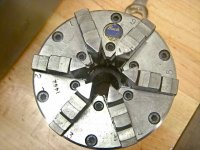northeastconfederate
Cast Iron
- Joined
- Jan 25, 2005
- Location
- New Egypt, NJ
Hi all,
I've been wondering about why newer chucks and backing plates universally seem to be so much thicker than older ones. I bought a 4-jaw chuck, supposedly direct mounting, which actually showed up with a 7/8" thick backing plate already bolted to it. Given the pretty sizable depth of the chuck itself (about 3" or so) and the large shoulder on the threaded portion of the backing plate, the chuck uses up 5+ inches of bed. Looking at older chucks, it seems they were all much "thinner", and if not direct mounting, the backing plate was a smaller diameter disc with not all that much mass. Why the change? Is the newer practice because the setup is that much more rigid? I own cheapo chucks, if I bought higher quality chucks would they be as bulky and "oversize" in this dimension? Even looking at pictures of large old lathes, great big chucks seem very narrow proportionally to the ones I have. I've been thinking of removing the 4-jaw from its backing plate and remachining the backing plate to reduce its size. This would gain me a little bed space (not much, granted) and reduce the weight of the thing a little. It seems an awful heavy weight cantilevered way out from the spindle nose. What gives? i have been using it like this for a couple of years, with no apparent ill effects, but it really bugs me, and recently created difficulty in turning a relatively long piece because of the loss of available bed (if I'm explaining that well enough to get my point across).
A similar issue is the coarseness of the threads on the jaw adjusting screws in my 4-jaw chuck. This makes centering a workpiece very difficult because the tiniest rotation of the jaw screw has a large affect on the work. Do higher quality chucks have finer threads on these screws making them easier to adjust?
Eric
I've been wondering about why newer chucks and backing plates universally seem to be so much thicker than older ones. I bought a 4-jaw chuck, supposedly direct mounting, which actually showed up with a 7/8" thick backing plate already bolted to it. Given the pretty sizable depth of the chuck itself (about 3" or so) and the large shoulder on the threaded portion of the backing plate, the chuck uses up 5+ inches of bed. Looking at older chucks, it seems they were all much "thinner", and if not direct mounting, the backing plate was a smaller diameter disc with not all that much mass. Why the change? Is the newer practice because the setup is that much more rigid? I own cheapo chucks, if I bought higher quality chucks would they be as bulky and "oversize" in this dimension? Even looking at pictures of large old lathes, great big chucks seem very narrow proportionally to the ones I have. I've been thinking of removing the 4-jaw from its backing plate and remachining the backing plate to reduce its size. This would gain me a little bed space (not much, granted) and reduce the weight of the thing a little. It seems an awful heavy weight cantilevered way out from the spindle nose. What gives? i have been using it like this for a couple of years, with no apparent ill effects, but it really bugs me, and recently created difficulty in turning a relatively long piece because of the loss of available bed (if I'm explaining that well enough to get my point across).
A similar issue is the coarseness of the threads on the jaw adjusting screws in my 4-jaw chuck. This makes centering a workpiece very difficult because the tiniest rotation of the jaw screw has a large affect on the work. Do higher quality chucks have finer threads on these screws making them easier to adjust?
Eric














 --- but you can see them at least.
--- but you can see them at least. But compare the specs: 2.36" deep and 9lbs for the solid, 6-jaw 4" model. That makes the new model double the weight and 37% more deep.
But compare the specs: 2.36" deep and 9lbs for the solid, 6-jaw 4" model. That makes the new model double the weight and 37% more deep.